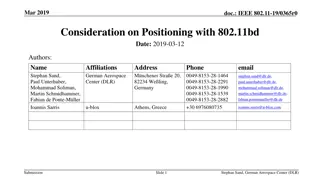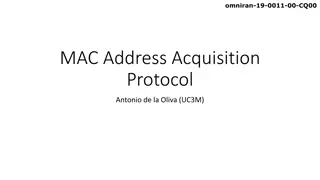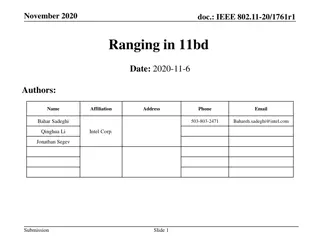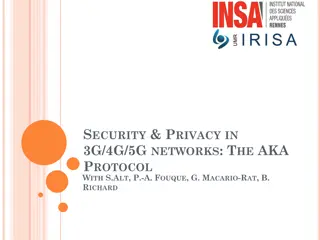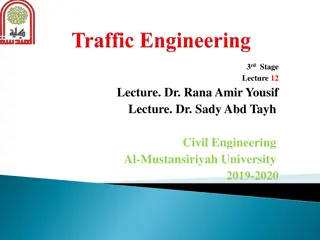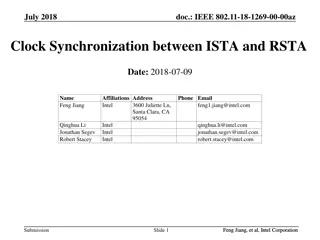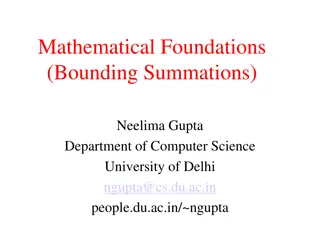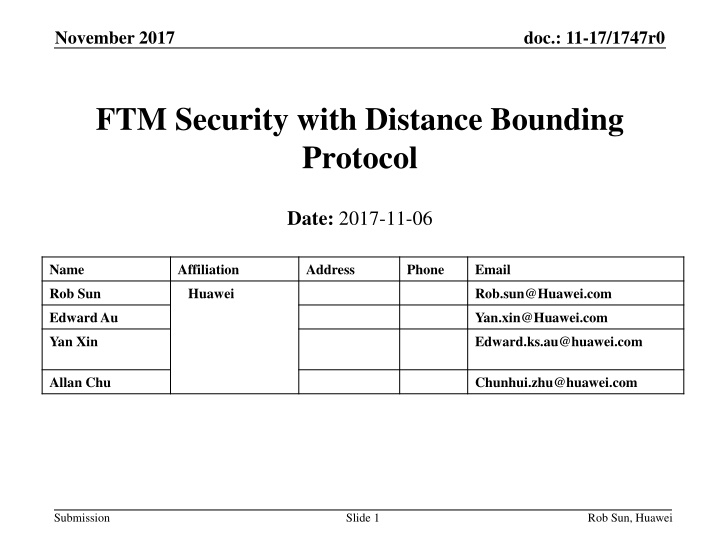
Enhancing FTM Security with Distance Bounding Protocol
Explore how FTM security is bolstered through Distance Bounding Protocol, mitigating vulnerabilities like replay attacks and enabling secure authentication for devices in various use cases such as personal identification systems and contactless payments.
Download Presentation

Please find below an Image/Link to download the presentation.
The content on the website is provided AS IS for your information and personal use only. It may not be sold, licensed, or shared on other websites without obtaining consent from the author. If you encounter any issues during the download, it is possible that the publisher has removed the file from their server.
You are allowed to download the files provided on this website for personal or commercial use, subject to the condition that they are used lawfully. All files are the property of their respective owners.
The content on the website is provided AS IS for your information and personal use only. It may not be sold, licensed, or shared on other websites without obtaining consent from the author.
E N D
Presentation Transcript
November 2017 doc.: 11-17/1747r0 FTM Security with Distance Bounding Protocol Date: 2017-11-06 Name Affiliation Address Phone Email Rob Sun Huawei Rob.sun@Huawei.com Edward Au Yan.xin@Huawei.com Yan Xin Edward.ks.au@huawei.com Allan Chu Chunhui.zhu@huawei.com Submission Slide 1 Rob Sun, Huawei
doc.: 11-17/1747r0 Rob Sun, et al Huawei FTM Security and landscape FTM security has been well studied along with many use cases, many of which are based on DH (Diffie-Hellman) protocol or DHE (Diffie-Hellman with Ephemeral Keys) Using DH(E) demands that both devices have to implement the proper DH cryptographic suites, and require the computation resources, which may not be ideal for some cases and some types of devices. Cryptographic Distance Bounding (DB) Protocol [3] was developed and described in this literature and it involves less resources than DH. By combing FTM with the DB protocol with enhancement, we can achieve the authenticity for the STAs, even in the un-associated State. Submission Slide 2
doc.: 11-17/1747r0 Rob Sun, et al Huawei What is Distance Bounding Protocol The FTM frames are subject to the replay attack at the FTM frames (including the FTM request frame) as they are lack of cryptographic protection as discussed in [1]. However, for some cases in which time sensitivity is high, delay is highly detectable, which becomes another dimension of PoI (Proof of Identity): Attacker have to process and forward the information that introduces delays (such as Type II MIM (man in the middle) attack) Some facts: Some off the shelf replay tools normally introduce ~20-50ms of delay in processing, and most of management message exchange are ~2ms, hence delay is highly detectable. By utilizing the pre-knowledge of the RTT time, it s feasible to combine FTM with the distance bounding protocol. Submission Slide 3
doc.: 11-17/1747r0 Rob Sun, et al Huawei Use Cases of Distance Bounding Personal Identification IEEE meeting attendance system or Access card system Vehicle collision prevention system Contactless payment system Toll gate system Submission Slide 4
doc.: 11-17/1747r0 Rob Sun, et al Huawei Threat Models Distance fraud: STA1 is a prover and also a bad guy Trying to deceive that AP with which he/she is in the range (Access card) Man In the Middle (MIM) The bad guy is replaying the messages between STA1 and AP Trying to deceive the AP and let AP calculate the wrong distance Mafia distance fraud (collusion) A.k.a the terrorists attack STA1 and the bad guy collude to deceive the AP. AP(Verifier) STA1 (prover) and bad guy AP(Verifier) STA1 (prover)Bad guy AP(Verifier) STA1 (prover)Bad guy Submission Slide 5
doc.: 11-17/1747r0 Rob Sun, et al Huawei Replay Attack and Distance Bounding Eve Eve Alice Bob Alice Bob FTM msg 1(params) FTM msg 1(params) FTM Msg 1 (params ) FTM Msg 1 (params ) FTM Ack FTM Ack FTM Ack FTM Ack Submission Slide 6
doc.: 11-17/1747r0 Distance Bounding Protocol based on Hancke and Kuhn Protocol [2] Bob as Verifier Pre-shared K Alice as Prover Pre-shared K Setup Phase Place a0 into the left shift register Place a1 into the right shift register Rapid bit exchange Phase for i = 1 to k Place a0 into the left shift register Place a1 into the right shift register Start timer Start timer Verification Phase Slide 7 Submission Rob Sun, et al Huawei
doc.: 11-17/1747r0 Rob Sun, et al Huawei Security Analysis of Hancke and Kuhn Protocol The Hancke and Kuhn protocol has the provable security bounds [3] against various attacks. Protocol Success Probability Distance-Fraud MIM Collusion-Fraud Hancke & Kuhn 1 where K denotes the rounds of bit challenges The Hancke and Kuhn protocol can provide some level of MIM resistance, and distance-fraud resistance as rounds of challenge increases. The Hancke and Kuhn protocol possesses the properties of efficiency and easy on hardware implementations. The Hancke and Kuhn Protocol is based on pre-shared key with an assumption of STA in association, what happens if a STA has no association yet? In order to mitigate the MIM attack, we need to enhance it (by mixing the challenges and/or response) Submission Slide 8
doc.: 11-17/1747r0 Rob Sun, et al Huawei Our Proposal: FTM protocol with Distance Bounding (FDB Protocol) Requirements FDB protocol should inherit Hanke & Kuhn protocol s properties, i.e low cost and low latency FTM frames and Acks, including the FTM requests, should be modified to accommodate the FDB protocol parameters. During the Rapid bit exchange Phase, the FTM frames should be sent in quick bursts (i.e gap_max <= 15ms) to prevent the replay attack (with less chance for processing delay). set ASAP=1 The number of bursts is required to be no less than 4 ( with assumption of 4 FTMs per burst, recommended) The number of FTMs per burst is required to be no less than 4 (recommended) The protocol should be applicable to both type of STAs, i.e (with pre-shared credentials [K]) and non-associated STAs (without [K]) Submission Slide 9
doc.: 11-17/1747r0 Our Scheme: FTM combined with Distance Bounding Protocol (With pre-shared K) Alice as Verifier (with pre-shared K) Bob as Prover ( with pre-shared K) Setup Phase Place a0 into the left shift register Place a1 into the right shift register Rapid bit exchange Phase for i = 1 to k Place a0 into the left shift register Place a1 into the right shift register Start timer Ends timer Random Skip Random Skip Start timer Ends timer B=Hash(K, MAC_A||MAC_B, c1 r1||c2 r2|| ck 0) Verification Phase Verify the B is correct If not correct, Send NAck Ack /NAck Submission Rob Sun, et al Huawei Slide 10
doc.: 11-17/1747r0 Our Scheme: FTM combined with Distance Bounding Protocol (W/O pre-shared K) Alice as Verifier Bob as Prover Setup Phase Place a0 into the left shift register Place a1 into the right shift register Rapid bit exchange Phase for i = 1 to k Place a0 into the left shift register Place a1 into the right shift register Start timer Ends timer Random Skip Random Skip Start timer Ends timer B=Hash(MAC_A||MAC_B, c1 r1||c2 r2|| ck 0) Verification Phase Verify the B is correct If not correct, Sends NAck Ack /NAck Submission Rob Sun, et al Huawei Slide 11
doc.: 11-17/1747r0 Rob Sun, et al Huawei FTM Random Skip with bogus bit During FTM transmission, the Verifier (Alice) could use the random skip technique as extra protection from the MIM attack. The random skip could use an indication bit b bogus bit within the FTM frames to indicate that the receiver (prover Bob) will need to skip the Ack while receiving the bogus bit. The default value of the b bit =0 , when b bit is set to 1, it means it runs the random skip. The placement of the Random Skip is randomly chosen by the sender. The FTM Random Skip with bogus bit requires no processing delay compared with other options. Submission Slide 12
doc.: 11-17/1747r0 Rob Sun, et al Huawei FDB protocol without bogus bit b by XOR (Random Skip) There exists other techniques to avoid the bogus bit b since b can still be detected, and attacker can still take active actions. At the rapid bit exchange phase, both the verifier Alice and prover Bob both needs to cache the all the Ci bits in transmission. Put the Ci and Ri bits in two 4 or 8 bits shift registers (C and R) sequentially after each sending and receiving at both ends. i.e the initial state of shift register is filled with 0000 When C1 (for example 1 ) is sent and received, the shift register for Ci would be 0001. When C2( for example 0 ) is sent and received, the shift register for Ci would be 0010. Keep inserting the new Ci and Ri bit into the right most bit position of the C & R shift register. The same procedure for R shift register Result=C R, if Result=0101, then both parties would R, if Result=0101, then both parties would know at the current receiving state, it would skip the know at the current receiving state, it would skip the Ack (Which is equivalent to using the bogus bit as Ack (Which is equivalent to using the bogus bit as indication. If Results = others, it would carry the normal indication. If Results = others, it would carry the normal operation. operation. Note: Here the denotes the bitwise XOR Note: Here the denotes the bitwise XOR The chance of getting a No Ack transmission, would be The chance of getting a No Ack transmission, would be 1/16. 1/16. Init C: 0 0 0 0 Results=0000 Init R: 0 0 0 0 C1: 0 0 0 1 Results=0001 R1: 0 0 0 0 C1: 0 0 1 1 Results=0011 R1: 0 0 0 0 Cn: 1 1 0 0 Results=0101 Rn: 1 0 0 1 Submission Slide 13
doc.: 11-17/1747r0 Rob Sun, et al Huawei FDB protocol without bogus bit b by Hashing (Random Skip) At the rapid bit exchange phase, both the verifier Alice and prover Bob both needs to cache the all the Ci bits in transmission. Put the Ci and Ri bits in two 8 bits shift registers (C and R) sequentially after each sending and receiving at both ends. i.e the initial state of shift register is filled with 00000000 When C1 (for example 1 ) is sent and received, the shift register for Ci would be 00000001. When C2( for example 0 ) is sent and received, the shift register for Ci would be 00000010. Keep inserting the new Ci and Ri bit into the right most bit position of the C & R shift register. The same procedure for R shift register Result=Trucate-L4B(Hash (C,R)) if Result=0101), ,R)) if Result=0101), then both parties would know at the current receiving then both parties would know at the current receiving state, it would skip the Ack (Which is equivalent to state, it would skip the Ack (Which is equivalent to using the bogus bit as indication. If Results = others, it using the bogus bit as indication. If Results = others, it would carry the normal operation. would carry the normal operation. Note: The Trucate Note: The Trucate- -L4B denotes the truncation to the L4B denotes the truncation to the left most 4 bits left most 4 bits Init C: 0 0 0 0 0 0 0 0 Hash Results=0100 0 0 0 0 0 0 0 0 Init R: 0 0 0 0 0 0 0 1 C1: Hash Results=0100 0 0 0 0 0 0 0 0 R1: C1: 0 0 0 0 0 0 1 1 Hash Results=0100 0 0 0 0 0 0 0 1 R1: 1 0 1 1 0 1 1 1 Cn: Hash Results=0101 1 1 0 0 0 0 0 1 Rn: Submission Slide 14
doc.: 11-17/1747r0 Rob Sun, et al Huawei Purpose of Random Skip Adding MIM attack detection capability. Adding memory and computation cost and delay to attackers. If using hashing, since MIM would add extra computation delay if it s active hijacking, the T would be detectable (with some off the shelf replay tools, it s observed the hashing would add another ~20ms- 50ms of delay) Adding the security protection of proof of knowledges for both valid parties. Each option of the Random Skip possess different properties. Delay 0 Random Skip Bogus Bit XOR Hashing (about 5 cycles/round) High (> 20ms) 1bit/round (or 1byte counting reserved bits) Overhead on transmission 0 0 Low (bogus bit is easy to detect) High (<=1/4) High (<=1/4) Security Protection Submission Slide 15
doc.: 11-17/1747r0 Rob Sun, et al Huawei FDB protocol security analysis Maintain Hancke and Kuhn protocol security property Improvement includes: Random Skip is to improve the MIM attack resistance. Random Skip is randomly chosen in the sequence of FTM frames. Remove the dependency on the Pre-shared key which is suitable for the unassociated STAs scenarios. Adding the mutual authentication function at the end of the FTM frame handshake, which to improve the MIM attack resistance Redefine the Ack frame with inclusion of the fields Define the NAck (Negative-Ack) frame to indicate the detection of MIM If both parties are associated, then the hash function is keyed hash function, i.e CMAC If both parties are unassociated, then the hash function is regular non-key based hash function, i.e PRF function Submission Slide 16
doc.: 11-17/1747r0 Rob Sun, et al Huawei False Accept Probability, n=2 False Accept Proability n=1 0.035 0.14 0.03 0.12 0.025 0.1 0.02 0.08 0.015 0.06 0.01 0.04 0.005 0.02 0 0 1 3 5 7 9 11 13 15 17 19 21 23 25 27 29 31 1 3 5 7 9 11 13 15 17 19 21 23 25 27 29 31 k=8 k=16 k=32 k=8 k=16 k=32 False Accept Probability, n=3 False Accept Probability, n=4 0.009 0.0025 0.008 0.007 0.002 0.006 0.005 0.0015 0.004 0.001 0.003 0.002 0.0005 0.001 0 0 1 3 5 7 9 11 13 15 17 19 21 23 25 27 29 31 1 3 5 7 9 11 13 15 17 19 21 23 25 27 29 31 k=8 k=16 k=32 k=8 k=16 k=32 Submission Slide 17
doc.: 11-17/1747r0 Rob Sun, et al Huawei FDB MIM False-accept Probability Analysis Mathematical Model: In practice, many of the sampled Ci or Ri bits may be corrupted. Therefore, a verifier will have to accept a prover as valid, even if at least ? out of received Ri bits were correct. An attacker can guess at least ? out of the k response bits Ri right with the false- accept probability ( ?<= k). The attacker can guess the Ack or NAck with probability of . The attacker can guess the random skip probability of , assuming there are n random skips. The False-accept probability is really depending on the number of FTM rounds (k) and n, the number of random skips. In short, the more rounds of the FTM bursts will reduce the false-accept probability Submission Slide 18
doc.: 11-17/1747r0 Rob Sun, et al Huawei Illustration of FDB protocol prevent MIM attack (Type I) Two types of MIM attack Type I: Dummy Reflector Bad Guy forwards any message without any modifications as transparent If the MIM attack is a reflector attack, there are a few properties: Reflector attack could be detected with some probability (False-accept Probability) The harm is trivial compared with Type II attack The mutual authentication and the last round of ACK/NACK mechanism will provide mitigation. AP(Verifier) a b STA(Prover) a b Bad guy Submission Slide 19
doc.: 11-17/1747r0 Rob Sun, et al Huawei Illustration of FDB protocol prevent MIM attack (Type II) Type II: Smarty Hijacking Bad Guy process and forward any message with modifications to pretend as valid. If the MIM attack is a hijacking attack, there are a few properties: Hijacking attack could be detected with some probability (False-accept Probability) The mutual authentication at the end of the FTM exchange, will defeat this type of attack. The Random Skip will also help to detect the MIM, as the bad guy may either need to capture all the challenges and responses, or have to guess the results of the Random skip results. AP(Verifier) a b STA(Prover) A B Bad guy Submission Slide 20
doc.: 11-17/1747r0 Rob Sun, et al Huawei Our Proposals To modify the FTM frames with extra fields to accommodate the FDB protocol. To define the new Ack. To define that FTM protocol to be able to transmit and receive the NAck. To define the FDB protocol and process parameters. Submission Slide 21
doc.: 11-17/1747r0 Rob Sun, et al Huawei References [1] 11-16-1020-00-00az, Qi Wang et al , Security enhancement to FTM [2] Gerhard P. Hancke, Markus G. Kuhn, An RFID Distance Bounding Protocol [3] Ioana Boureanu et al, Towards Secure Distance bounding Submission Slide 22
doc.: 11-17/1747r0 Rob Sun, et al Huawei Further Study Submission Slide 23






